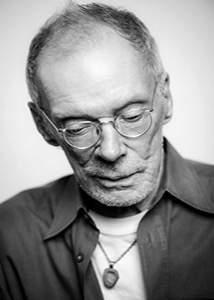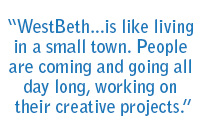 Painter and writer John (Jack) Dowling was born in Woodbridge, New Jersey in 1931. After attending Cooper Union and teaching in Italy for a few years, he settled in New York to be a painter before eventually turning to writing. His stories have been published in the Hamilton Stone Review, the Barcelona Review, A&U Magazine, and American Writing. He has been a resident of WestBeth since 1971.
Painter and writer John (Jack) Dowling was born in Woodbridge, New Jersey in 1931. After attending Cooper Union and teaching in Italy for a few years, he settled in New York to be a painter before eventually turning to writing. His stories have been published in the Hamilton Stone Review, the Barcelona Review, A&U Magazine, and American Writing. He has been a resident of WestBeth since 1971.
Jack Dowling spent the first two decades of his life in New York City as a painter. “There were centers of activity in the Village and I just quietly began to paint,” he says. “At some point I gave up painting abstractly because I wasn’t sure where that was going. One day, I picked up a snapshot of my parents on their wedding day and decided to make a painting from that. I developed that into a kind of semi-abstraction and got very involved in the sense of light, color, and shadow. That resulted in a whole series of paintings that had their initial source in photographs.”
What made him stop painting and take up writing? “It sounds like a sob story,” he says, laughing. “I had a large loft and I got involved in a court case trying to save it. It cost me money that I didn’t have, which sent me into the job market and diverted me from my painting. After three years, I lost the loft and I was homeless at 40!” He laughs. “But I got myself reorganized and into WestBeth in a ‘starter’ apartment. I was still working at the job that I had gotten to survive but I had also decided I didn’t want to paint anymore. In the meantime I began to jot down various short observations and channel my creative energy in that direction.”
Does he find writing different than painting? “Writing is very creative, but it’s ten times harder than painting was for me,” Dowling admits. “I worked really hard because in the beginning I couldn’t write anything more than a big paragraph. I still have to write and rewrite because I don’t have an easy time constructing a story that is grammatically proper. At the same time, I don’t want to make it so correct that it loses its punch. So it took me a number of years to figure out how to write my stories.”
Having lived in New York since the early 50s, Dowling has spent most of those years in the neighborhood. “You could move around back then. You’d move into an apartment with your suitcase and maybe your cat on your shoulder. And then you’d hear about a nicer apartment somewhere else and you’d pick up and move. That was what the Village was like.” There was also a lively gay scene. “There were three gay bars on 8th Street back in the 50s,” he recalls. “There was Mary’s, the Colony which was also a restaurant, and then a place called Main Street. For a gay man, the Village was a comfortable, easy kind of place. I never felt like an outsider even when I was younger.”
By the 1970s, though, the Village was a “mess” as was the whole City. “When Westbeth first opened it was so gritty and grimy down here, still a factory neighborhood. It was not high-end by any means. Now there’s a ton of money in the Village! I saw a reference to 10014 as one of the zip codes with the highest incomes in NYC. But those of us in WestBeth wouldn’t know about that,” he says laughingly.
 “However, I love living here,” he continues. “Considering what’s become of New York, I feel fortunate to still be here and in WestBeth, which is like living in a small town. People are coming and going all day long, working on their creative projects. It’s not like other apartment buildings here in the neighborhood that are dormant all day long; we’re a thriving, energetic jewel right in the middle of what’s become a rather boring neighborhood.”
“However, I love living here,” he continues. “Considering what’s become of New York, I feel fortunate to still be here and in WestBeth, which is like living in a small town. People are coming and going all day long, working on their creative projects. It’s not like other apartment buildings here in the neighborhood that are dormant all day long; we’re a thriving, energetic jewel right in the middle of what’s become a rather boring neighborhood.”
When asked what it is about the artistic process that attracted him in the first place, Dowling responds, “For myself, I feel I was born with it. Never for a moment did I consider following in my businessman father’s footsteps. Instead, I was always thinking about stuff to make. That’s a good part of it. There are a lot of people in creative fields who didn’t have a choice. We’re just drawn into it and we can’t resist it.”
Photo: David Plakke
